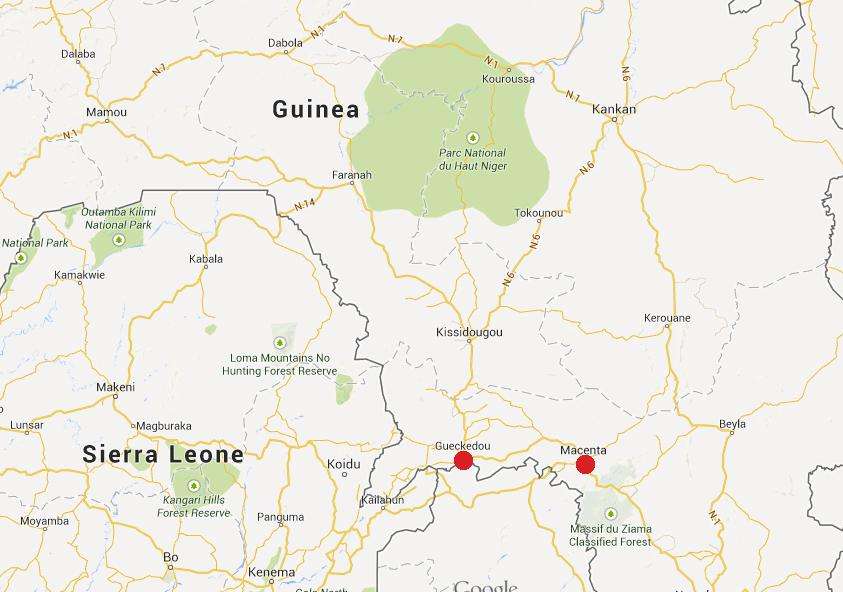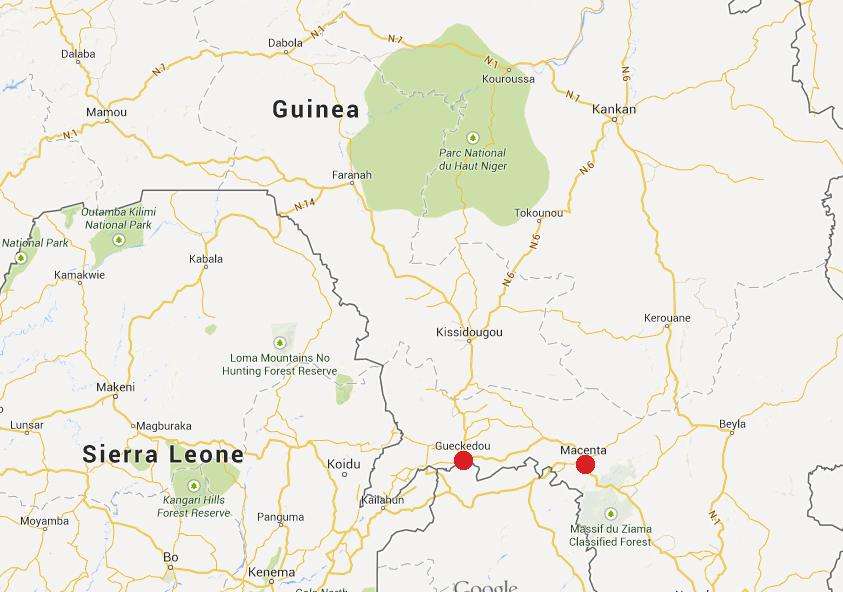The Ebola epidemic in Guinea, confirmed by the Ministry of Health on March 22, is the first to affect the country. The latest official statistics put the toll at 86 suspected cases and 59 deaths.
The priority of the teams on site is to identify patients with Ebola symptoms and isolate them, while providing high-quality care.
In cooperation with the Ministry of Health, Doctors Without Borders/Médecins Sans Frontières (MSF) created an isolation facility in Guéckédou and is setting up another in Macenta. Both towns are in the Forestière region of southern Guinea.
Mobile teams are also evaluating the situation in Kissidougou and Nzérékoré and are monitoring bordering countries closely, particularly Sierra Leone and Liberia, where suspected cases have been reported.
Ebola refers to several strains of the same virus, first identified in humans in 1976 in Sudan and the Democratic Republic of Congo (DRC), along the Ebola River. Ebola viruses produce devastating illnesses, most often leading to death. They cause hemorrhagic fevers, which lead to internal and external bleeding, similar to Marburg fever, which results from a related virus. There is no treatment and no vaccine.
Certain species of bats living in the tropical forests of Central and West Africa are thought to be Ebola’s natural reservoir. While they carry viruses, they show no symptoms and appear to contaminate large monkeys and humans through their droppings or bites. Humans can also catch the virus after contact with infected animals, dead or living, or from other infected persons.
The last Ebola epidemics killed several dozen people in late summer 2012 in Uganda and DRC. Although it is very dangerous, Ebola remains rare. Since the virus was discovered in 1976, approximately 2,200 cases have been recorded. Of those, 1,500 were fatal. However, sporadic cases and even epidemics have certainly gone undetected because they occur in areas where people lack access to medical care.
Dr. Esther Sterk, MSF tropical medicine advisor, provides further explanation in the following Q&A.
What are Ebola’s distinctive features?
This is a rare disease. Epidemics are limited, but they create panic every time because Ebola is fatal in 25 to 90 percent of cases. After an incubation period of 2 to 21 days, the virus causes a raging fever, headaches, muscle pain, conjunctivitis, and general weakness. The next phase involves vomiting, diarrhea and, sometimes, a rash. The virus spreads in the blood and paralyzes the immune system. It is particularly formidable because the body does not detect these viruses right away. When the organism does respond, it is often too late. By then, the viruses have created blood clots, which block vital organs and cause major hemorrhages. Patients may have heavy bleeding, including from the nose or via their urine.
The disease is transmitted by contact with the fluids of infected people or animals, such as urine, sweat, blood, or mother’s milk. Family members and health care workers treating patients are at great risk of infection. The high mortality rate and bleeding are so frightening that health care workers often flee, abandoning patients.
Funeral traditions in which family members wash the body of the deceased are also a major means of transmission in African communities.
How does MSF respond to Ebola epidemics, given that there is no treatment?
Although there is no cure for this disease, we can reduce its very high mortality by addressing the symptoms. This includes administering a drip to patients who have become dehydrated from diarrhea and by confirming that they do not have a different disease, such as malaria or a bacterial infection like typhoid. Vitamins and anti-pain medication can also be useful. When the person loses consciousness and bleeds copiously, there is no hope. At that point, we ease the patient’s pain and stay with him until the end.
Once the first case is confirmed by a blood test, every person who cares for an infected patient must wear a hazmat suit, gloves, a mask, and protective goggles, and exercise extreme caution when administering treatment. Decontamination chambers are generally installed between the isolated patients and the external environment. To confine the epidemic, it is critical to trace the entire transmission chain. All individuals who have had contact with patients who may be contaminated are monitored and isolated at the first sign of infection. The affected communities must also be informed about the illness and the precautions to be taken to limit risks of contamination. Basic hygiene—such as washing one’s hands—can significantly reduce the risk of transmission.
What are the prospects for the fight against Ebola?
Although several countries are interested in it in connection with protecting against bacteriological warfare or bioterrorism, the research is limited. The small number of epidemics and patients restricts the investigations. To develop vaccines, you need a sufficient number of volunteers. Research is also underway on the origin of the virus and on bats, Ebola’s likely natural reservoir.
In recent years, MSF has been involved in nearly every Ebola epidemic. Other actors have also been present, but we can provide our experience in treating cases. Considerable materiel is often required to isolate patients and prevent contamination among health care workers. We are also trying to improve our response to these epidemics. That is the key to success. You’ve got to act as quickly as possible as soon as the first case is confirmed. The challenge is that Ebola occurs in isolated areas and it takes time to identify the disease and alert the health authorities. In addition, the early symptoms resemble those of malaria. We are training health care workers so that they can respond quickly.





